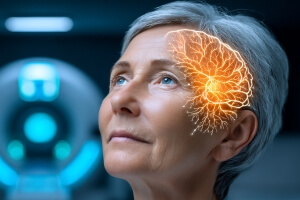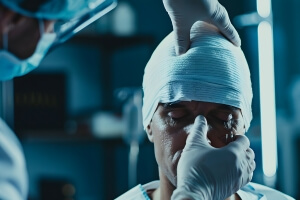Disorders We Provide Treatment For
Spinal Conditions
Low Back Pain
 Spinal pain in the low back is one of the most common reasons why patients go see their primary care physicians. The treatment of spinal pain varies on the cause of pain, a patient’s age or overall condition of health, and response to available treatment options.
Spinal pain in the low back is one of the most common reasons why patients go see their primary care physicians. The treatment of spinal pain varies on the cause of pain, a patient’s age or overall condition of health, and response to available treatment options.
When low back pain occurs with leg pain, the diagnosis is called lumbar radiculopathy. Radiculopathy is radiating pain which originates in the nerve in the spine. Pain signals are sent shooting down the leg in response to, for example, a herniated disc, or pinching from a variety of tissues located in the lumbar spine. If nonoperative treatment fails, then surgery is an option for pain. Nonoperative treatment usually consists of physical therapy and pain management programs.
Surgery is tailored to each individual’s specific complaints. Some patients are recommended to have surgery immediately if there is serious compromise to the health of the nerve. However, most surgeries are well thought out by both the surgeon and the patient in order to achieve the best possible outcome for each individual patient. Nerve decompressions, discectomies, and spinal fusions are common techniques used to eliminate low back and leg pain.
Neck Pain
 Spinal pain in the back of the neck is another common reason to visit the doctor. Getting a good night’s sleep is very difficult with neck pain. Narcotics and muscle relaxants for spasms in the neck are often the first line treatment. Physical therapy and cervical traction may also help provide pain relief. When pain travels from the neck to the arm, it is called cervical radiculopathy. When a nerve in the neck is pinched by a bonespur or a disc bulge, arm pain can make working very difficult.
Spinal pain in the back of the neck is another common reason to visit the doctor. Getting a good night’s sleep is very difficult with neck pain. Narcotics and muscle relaxants for spasms in the neck are often the first line treatment. Physical therapy and cervical traction may also help provide pain relief. When pain travels from the neck to the arm, it is called cervical radiculopathy. When a nerve in the neck is pinched by a bonespur or a disc bulge, arm pain can make working very difficult.
Surgery is reserved for patients who do not improve with physical therapy and pain management, while showing abnormalities to explain the pain symptoms on MRI. Surgery for cervical pain can be performed from the front or the back of the neck. The exact nature of the operation depends on the complaints of the patient. Each surgery is chosen specifically to match the problems of the patients to end with the best possible outcome.
Spinal Stenosis
 Stenosis means narrowing of the canal which contains either the spinal cord or nerves attached to the spinal cord. Depending on where the location of spinal stenosis exists, the goals of surgery and expectations of recovery vary widely. Spinal stenosis of the low back usually occurs as people get older and arthritis progresses. Burning and disabling pain in the back of the legs that improves when sitting down is a hallmark of the disorder. Surgery is designed to take the pressure off nerves, so people can walk farther distances without excruciating leg pain.
Stenosis means narrowing of the canal which contains either the spinal cord or nerves attached to the spinal cord. Depending on where the location of spinal stenosis exists, the goals of surgery and expectations of recovery vary widely. Spinal stenosis of the low back usually occurs as people get older and arthritis progresses. Burning and disabling pain in the back of the legs that improves when sitting down is a hallmark of the disorder. Surgery is designed to take the pressure off nerves, so people can walk farther distances without excruciating leg pain.
Spinal stenosis of the neck is difficult to identify because patients usually complain of numbness of the hands or difficulty walking, rather than pain. Once an MRI shows the narrowing, then surgical treatments are discussed on an individual basis. Surgery can be performed from the front or the back of the neck, and usually requires a cervical fusion for stability. Significant disability can be avoided by taking the pressure off the spinal cord caused by degenerative arthritis or disc disorders.
Scoliosis
 Many patients who suffer from chronic low back and leg pain, often have a history of scoliosis. Scoliosis is a curve of the spine. Some people are born with it, and others develop scoliosis with age. If medical therapy does not improve pain sufficiently, then surgery is an option. Laminoforamenotomy with discectomy can be performed to take pressure off a single nerve. For the treatment of severe back pain, surgery can be designed to straighten the spinal curve. This type of surgery is called corrective surgery for spinal deformity.
Many patients who suffer from chronic low back and leg pain, often have a history of scoliosis. Scoliosis is a curve of the spine. Some people are born with it, and others develop scoliosis with age. If medical therapy does not improve pain sufficiently, then surgery is an option. Laminoforamenotomy with discectomy can be performed to take pressure off a single nerve. For the treatment of severe back pain, surgery can be designed to straighten the spinal curve. This type of surgery is called corrective surgery for spinal deformity.
Cranial Conditions
Hydrocephalus
 Hydrocephalus is a condition where there is an abnormal amount of fluid in the brain. Normally, our brain contains cerebrospinal fluid in compartments called the ventricles. When the ventricles enlarge, symptoms may occur such as headaches, visual changes and confusion. When pressure builds in the ventricles, they can enlarge and may require a procedure called a ventriculoperitoneal shunt. A shunt is a plastic tube that drains the fluid under the skin to the abdominal region. Shunts are usually permanent, but because they can become blocked, they may need to be tested or changed throughout one’s life.
Hydrocephalus is a condition where there is an abnormal amount of fluid in the brain. Normally, our brain contains cerebrospinal fluid in compartments called the ventricles. When the ventricles enlarge, symptoms may occur such as headaches, visual changes and confusion. When pressure builds in the ventricles, they can enlarge and may require a procedure called a ventriculoperitoneal shunt. A shunt is a plastic tube that drains the fluid under the skin to the abdominal region. Shunts are usually permanent, but because they can become blocked, they may need to be tested or changed throughout one’s life.
When patients develop memory changes, urinary incontinence and difficulty walking, and have an MRI showing large ventricles, then the diagnosis of normal pressure hydrocephalus or NPH often is discussed. If there is improvement in any of these functions by removing a small amount of spinal fluid, then shunting may be beneficial. Most surgeries involve the placement of a metallic valve which controls the flow of spinal fluid from the brain. If entering a magnet area such as an MRI, patients must remember to return to the neurosurgeon to have the valve reprogramed to the proper flow parameters.
Brain Tumor
 Surgery is often required after an MRI demonstrates the presence of a brain tumor. Surgery may be a biopsy or a craniotomy designed to take specimens of abnormal tissue to pathology to evaluate the type of tumor, and also to remove the abnormal tissue. Since some tumors can be successfully treated with chemotherapy, a biopsy followed by a comprehensive treatment plan is often the best first treatment. Once a diagnosis is established, neurosurgeons work very closely with oncologists and radiation oncologists to either control or eliminate the brain tumor. We use state-of-the-art tumor imaging technology in the operating room to localize tumors and provide the most successful outcomes possible. Once surgery is performed, we strive to make the transition to postoperative treatment as comfortable as possible, and continue to monitor your progress along with the other doctors involved in your care.
Surgery is often required after an MRI demonstrates the presence of a brain tumor. Surgery may be a biopsy or a craniotomy designed to take specimens of abnormal tissue to pathology to evaluate the type of tumor, and also to remove the abnormal tissue. Since some tumors can be successfully treated with chemotherapy, a biopsy followed by a comprehensive treatment plan is often the best first treatment. Once a diagnosis is established, neurosurgeons work very closely with oncologists and radiation oncologists to either control or eliminate the brain tumor. We use state-of-the-art tumor imaging technology in the operating room to localize tumors and provide the most successful outcomes possible. Once surgery is performed, we strive to make the transition to postoperative treatment as comfortable as possible, and continue to monitor your progress along with the other doctors involved in your care.
Meninigoma
 Meninigomas are tumors of the lining of the brain called the meninges. They can grow next to the brain, but they are not brain tumors. If they cause the brain to swell, then seizures or symptoms may begin to develop. Most patients who have tumors that appear classic for meningioma on MRI are watched without the need for biopsy or surgery. If the tumor grows or symptoms worsen over time, then surgery is usually performed. Treatment options for meningiomas include either surgery for removal or radiosurgery. The goal of radiosurgery is tumor control. The tumor may not disappear, but if the radiation stops it from growing in areas difficult to reach with surgery, then the tumor may not cause any more harm.
Meninigomas are tumors of the lining of the brain called the meninges. They can grow next to the brain, but they are not brain tumors. If they cause the brain to swell, then seizures or symptoms may begin to develop. Most patients who have tumors that appear classic for meningioma on MRI are watched without the need for biopsy or surgery. If the tumor grows or symptoms worsen over time, then surgery is usually performed. Treatment options for meningiomas include either surgery for removal or radiosurgery. The goal of radiosurgery is tumor control. The tumor may not disappear, but if the radiation stops it from growing in areas difficult to reach with surgery, then the tumor may not cause any more harm.
Pituitary Tumor
 The pituitary is an extension of the brain which releases hormones to the rest of the body. The most common tumor which grows from this gland is called pituitary adenomas. These are benign tumors which usually don’t release any hormones. Often the tumors are located next to the optic nerves, and will cause vision changes, such as tunnel vision. An eye exam is used to document the extent of visual changes when a pituitary tumor is diagnosed. In addition, patients with pituitary tumors will visit the endocrinologist prior to surgery because some pituitary tumors can be treated with medical treatment alone.
The pituitary is an extension of the brain which releases hormones to the rest of the body. The most common tumor which grows from this gland is called pituitary adenomas. These are benign tumors which usually don’t release any hormones. Often the tumors are located next to the optic nerves, and will cause vision changes, such as tunnel vision. An eye exam is used to document the extent of visual changes when a pituitary tumor is diagnosed. In addition, patients with pituitary tumors will visit the endocrinologist prior to surgery because some pituitary tumors can be treated with medical treatment alone.
The treatment options for pituitary tumors are observation, stereotactic radiation, or surgery depending upon the type and size of the tumor and the symptoms that the tumor is creating on the surrounding structures. The surgical approach is most commonly “trans-nasal,” or through the nose to access the gland.
Head Trauma
 Sometimes at night, a significant number of patients can be admitted to the hospital with head injuries and require an evaluation by a neurosurgeon in the emergency room. Some patients require emergency surgery for life-threatening conditions, such as those caused after car accidents.
Sometimes at night, a significant number of patients can be admitted to the hospital with head injuries and require an evaluation by a neurosurgeon in the emergency room. Some patients require emergency surgery for life-threatening conditions, such as those caused after car accidents.
The goal is usually to relieve the high pressure from within the brain that’s caused by bleeding or brain swelling. Some patients heal quickly, while others take up to 3 months to heal to the point of being able to leave the hospital.
Spinal Trauma
 Some patients have other injuries such as spinal injuries which need to be addressed once the head injury has been resolved. When there is a spinal fracture, a neurosurgeon will be called to assess the treatment options. Although most spinal fractures will heal with bracing, fractures that press on nerves or the spinal cord can cause permanent damage if not fixed as soon as possible.
Some patients have other injuries such as spinal injuries which need to be addressed once the head injury has been resolved. When there is a spinal fracture, a neurosurgeon will be called to assess the treatment options. Although most spinal fractures will heal with bracing, fractures that press on nerves or the spinal cord can cause permanent damage if not fixed as soon as possible.
X-rays, CT Scans, and MRIs are used to determine the best course of action to fix a particular spinal fracture. Complex reconstructive surgery requiring spinal implants and instrumentation is often required to provide stability and long-lasting support to the spinal column. After surgery, most patients are enrolled in physical therapy and encouraged to walk to regain muscle strength. Rehabilitation allows damaged connections caused by the original spinal injury to heal and recover.
Metastatic Disease
 Most cranial metastases are silent, and are diagnosed after a metastatic workup for cancer. Because stereotactic radiosurgery and whole brain radiation provides excellent tumor control in the brain, most patients with multiple brain metastases will undergo radiation for multiple lesions. The role for surgery for brain metastases continues to be very important, and is selected for single, larger lesions often next to sensitive structures of the brain.
Most cranial metastases are silent, and are diagnosed after a metastatic workup for cancer. Because stereotactic radiosurgery and whole brain radiation provides excellent tumor control in the brain, most patients with multiple brain metastases will undergo radiation for multiple lesions. The role for surgery for brain metastases continues to be very important, and is selected for single, larger lesions often next to sensitive structures of the brain.
When metastatic lesions appear in the spine, a biopsy may be performed if there is no clear diagnosis. When symptoms progress such as weakness or numbness of the arms or legs, individual lesions may be surgically removed and the spine stabilized. Symptoms of weakness, numbness and pain can often improve after spinal decompression and stabilization. After surgery, chemotherapy and radiation are usually required.
Glossary
Aneurysm – a balloon like structure on the side of a blood vessel. Aneurysms usually develop where blood vessels divide into two vessels. The risk of rupture is associated with their location, size, and history of aneurysm rupture. Smoking and high blood pressure may be associated with the formation of aneurysms. Treatment is endovascular coiling or craniotomy clipping of the aneurysm. Both achieve a final goal of decreasing or eliminating the risk of rupture.
Craniotomy – an operation on the head which entails cutting bone to perform surgery on the brain. The skull bone flap is returned to the normal position to cover the brain with a titanium mini-plating system.
Craniectomy – an operation on the head which entails cutting bone to perform surgery on the brain. The skull bone flap is intentionally not returned, to allow for brain swelling. A second surgery is scheduled after proper healing to return a boneplate to the skull.
Disc – the cushion between the vertebral bodies.
Discectomy – surgery that’s performed to partially or completely remove disc material. The goal of this operation is to take pressure off the nerves or spinal cord, and eliminate abnormal symptoms such as pain. When the disc wall tears, it can herniate; a fragment of tissue from within the disc moves to an abnormal location outside of the disc, placing pressure on the nerve.
Meningioma – a tumor of the lining of the brain called the meninges. This type of tumor is usually benign, and can press against the brain to cause a variety of symptoms. Surgery and radiosurgery are two treatment options to control this type of tumor.
Spinal decompression – Pain, numbness, weakness, or incontinence can occur when nerves or spinal cord are under abnormal amounts of pressure. Surgery can be performed to take the pressure off the nerves or spinal cord to improve one’s quality of life. Pressure can be caused by bone spurs, overgrown tissue, or disc bulges. Surgical treatment consists of removing these troublesome tissues in order to give nerves and the spinal cord more room. Often the nerves will heal themselves if pressure is eliminated, and pain will resolve, allowing patients the chance to return to work and lead a much improved quality of life.
Spinal fusion – Fusion is the process of causing bones to grow together after surgery is performed. The goal of a fusion is usually to decrease pain and improve overall function and quality of life. Hardware such as titanium screws and rods may be used to situate bones to achieve a fusion. The process of fusion within the body can take several months to heal.
